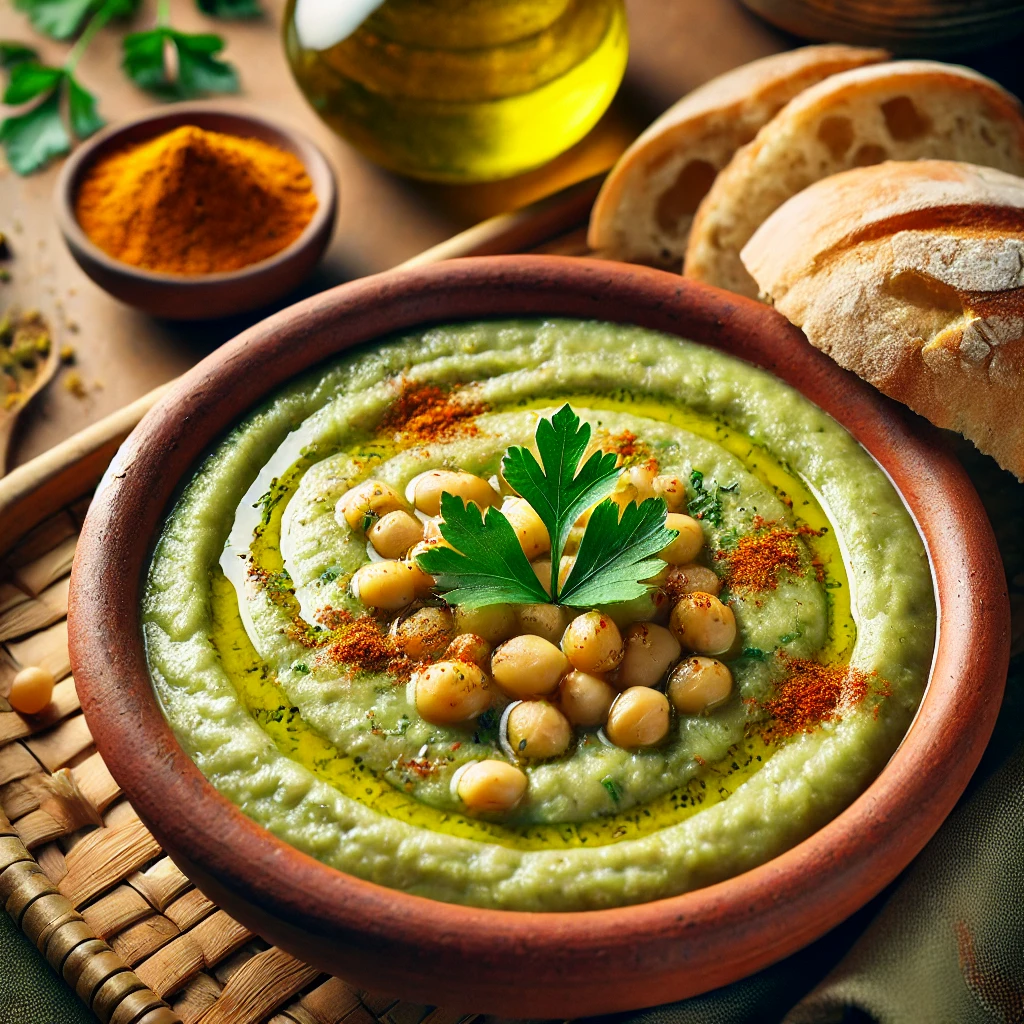Introduction: What is Bissara?
Bissara, also known as Bessara or Bissara, is a popular Moroccan dish made from pureed fava beans or split peas, often served as a dip or soup. It’s a humble, yet flavorful dish that’s commonly eaten for breakfast or lunch, especially in the colder months.
With its smooth, creamy texture and the earthy, nutty flavor of fava beans, bissara is typically drizzled with olive oil and topped with cumin, paprika, and garlic for extra depth of flavor. This dish is both nutritious and comforting, making it a beloved staple in Moroccan households.
Whether you’re enjoying it as a warm, hearty soup or as a dip with fresh bread, Bissara is a simple and satisfying dish that’s easy to make at home.
Ingredients for Bissara
The ingredients for Bissara are simple and affordable, yet they create a rich and flavorful dish. Here’s what you’ll need:
Core Ingredients:
- 300g dried fava beans (or split peas)
- 4-5 cups water (for cooking)
- 4 cloves garlic (peeled and smashed)
- 1 tsp ground cumin
- 1 tsp ground paprika (optional, for garnish)
- 1/4 cup olive oil (plus extra for drizzling)
- Salt and pepper to taste
- Fresh lemon wedges (optional, for serving)
How to Make Bissara: Step-by-Step Guide
Step 1: Prepare and Soak the Fava Beans
- If using dried fava beans, you’ll need to soak them overnight in cold water. Soaking the beans helps to soften them, making them easier to cook and digest.
- If you’re using split peas, soaking is not necessary, and you can proceed directly to cooking.
Step 2: Cook the Beans
- Drain the soaked fava beans and place them in a large pot. Add 4-5 cups of water, or enough to cover the beans by about 2 inches.
- Add the smashed garlic cloves to the pot. Bring the mixture to a boil, then reduce the heat to a simmer.
- Let the beans cook for 45-60 minutes, or until they are tender and easily mashed with a spoon. Stir occasionally and skim off any foam that rises to the surface.
Step 3: Blend the Bissara
- Once the beans are fully cooked and tender, use a handheld immersion blender to puree the mixture into a smooth, creamy consistency. Alternatively, you can transfer the mixture to a blender in batches.
- If the Bissara is too thick, you can add a bit more water to achieve the desired consistency. Some people prefer a thicker dip-like texture, while others enjoy it more like a soup.
Step 4: Season and Serve
- Stir in the olive oil, cumin, and season with salt and pepper to taste. Simmer the mixture for another 5-10 minutes to allow the flavors to blend.
- Ladle the Bissara into bowls, and drizzle with extra olive oil. Sprinkle ground cumin and paprika on top for garnish, and serve hot with fresh bread or lemon wedges.
Tips for the Perfect Bissara
- Use Fresh Spices: To maximize the flavor, use fresh ground cumin and paprika. These spices are key to achieving the signature warmth and depth in Bissara.
- Adjust the Texture: Bissara can be served either thick like a dip or thinner like a soup. Simply adjust the amount of water during the cooking process to achieve your preferred consistency.
- Olive Oil for Flavor: A good-quality olive oil is essential for finishing the dish. The drizzle of olive oil on top adds richness and enhances the flavors.
- Optional Garnishes: Top your Bissara with finely chopped parsley or cilantro for a fresh, herbal note, or squeeze some lemon juice over the top for a bright, zesty finish.
Variations of Bissara
While the classic recipe is made with fava beans, there are many ways to adapt Bissara to your taste or dietary needs:
1. Split Pea Bissara
If you prefer split peas over fava beans, you can easily substitute them in this recipe. The process remains the same, and you’ll end up with a slightly different flavor and texture, but equally delicious.
2. Spicy Bissara
For those who enjoy a bit of heat, add a pinch of chili powder or cayenne pepper to the dish, or garnish with harissa (a Moroccan chili paste) for a spicier version of Bissara.
3. Garlic and Herb Bissara
If you’re a garlic lover, you can roast the garlic cloves before adding them to the beans for a sweeter, more intense flavor. Fresh herbs like parsley or cilantro can also be stirred into the finished dish for an extra burst of flavor.
How to Serve Bissara
Bissara is traditionally served hot and can be enjoyed in a variety of ways. Here are some popular serving suggestions:
- As a Dip: Serve Bissara as a dip with warm flatbread, pita, or crusty bread for dipping. It makes a great appetizer or snack.
- As a Soup: If you prefer a thinner consistency, serve Bissara as a soup. It pairs well with a drizzle of olive oil and a squeeze of lemon juice.
- With a Side of Veggies: For a healthy and balanced meal, serve Bissara alongside fresh or roasted vegetables like carrots, cucumbers, or bell peppers.
Conclusion: Enjoy Your Homemade Bissara
Whether you’re looking for a simple dip, a warm soup, or a healthy snack, Bissara is a versatile dish that’s packed with flavor and nutrition. Its creamy texture and rich taste, enhanced by garlic, cumin, and olive oil, make it a perfect comfort food that’s both easy and satisfying to make.
Give this traditional Moroccan recipe a try and enjoy the flavors of North Africa in your own home!
Call to Action: Ready to make your own Bissara? Follow this recipe and share your results using #BissaraMaster! Don’t forget to subscribe to our blog for more delicious recipes and cooking tips.
This guide provides you with everything you need to make a traditional Moroccan Bissara, with tips for customizing the recipe to your taste and preferences.

